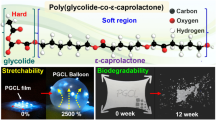Summary
A new method was developed to study the in vivo recovery of mechanical properties of rat skin after repeated strain. Full recovery, i.e., restitutio ad integrum, can be observed only in in vivo experiments but not in in vitro conditions. For the in vivo studies, tabs were fastened on the back skin of rats to test stress-strain behaviour both perpendicular and longitudinal to the body axis. Under anesthesia, skin was extended repeatedly 30 times to an elongation of up to 50% of the distance between the tabs. The experiment was repeated in the same animals at either 0.5, 1, 6, or 16 h. Differences depending on the direction of stretching versus body axis were observed during the first run. A decrease in stress values depending on the logarithm of the number of cycles was found, in both directions, to be attributable to the relaxation phenomenon. The measured stress values after 0.5, 1, and 6 h were considerably lower compared to the first run, thus indicating an incomplete recovery. After 16 h, an almost complete recovery was observed, so that, in perpendicular samples, even higher values were observed, thus indicating an overshooting of the repair mechanisms. The difficulties associated with obtaining appropriate physical and mathematical models for the mechanical properties of skin are discussed.
Similar content being viewed by others
References
Arnold G, Gross F, Harring J (1974) Zum Nachweis einiger mechanisch-rheologischer Eigenschaften des hyalinen Knorpels. Experientia 30:763
Barbenel JC, Payne PA (1981) In vivo mechanical testing of dermal properties. Bioengin Skin 3[1]:8–83
Buss V, Lippert H, Zech M, Arnold G (19769 Zur Biomechanik menschlicher Sehnen: Zusammenhänge von Relaxation und Spannungsrückgewinn. Arch Orthop Trauma Surg 86:169–182
Frisen M, Mägi M, Sonnerup L, Viidik A (1969) Rheological analysis of soft collagenous tissue. I. Theoretical considerations. J Biomech Eng 2:13
Frisen M, Mäge M, Sonnerup L, Viidik A (1969) Rheological analysis of soft collagenous tissue. II. Experimental evaluations and verifications. J Biomech Eng 2:21
Lanir Y (1979) A structural theory for the homogenous biaxial stress-strain relationship in flat collagenous tissues. J Biomech Eng 12:423–436
Ridge ND, Wright V (1964) The description of skin stiffness. Biorheology 2:67–74
Rigby BJ (1964) Effect of cyclic extension to the physical properties of tendon collagen and its possible relation to biological ageing of collagen. Nature 202:1072–1074
Rigby BJ, Hirai N, Spikes JD, Eyring H (1959) The mechanical properties of rat tail tendon. J Physiol 43:265–283
Veronda DR, Westmann RA (1970) Mechanical characterization of skin. Finite deformations. J Biomech Eng 3:111–124
Viidik A (1968) A rheological model for uncalcified parallelfibred collagenous tissue. J Biomech Eng 1:3–11
Vogel HG (1973) Stress relaxation in rat skin after treatment with hormones. J Med 4:19–27
Vogel HG (1976c) Tensile strength, relaxation and mechanical recovery in rat skin as influenced by maturation and age. J Med 7:177–188
Vogel HG (1976) Measurement of some viscoelastic properties of rat skin following repeated load. Connect Tissue Res 4:163–168
Vogel HG (1976) Einfluß von Alter und Corticosteroid-Behandlung auf die mechanischen Parameter der Haut von Ratten bei zyklischer Beanspruchung. G-I-T, Fachz Laboratorium 20:113
Vogel HG (1977) Strain of rat skin at constant load (creep experiments). Influence of age and desmotropic agents. Gerontology 23:77–86
Vogel HG (1978) Age dependence of mechanical parameters in rat skin following repeated strain. Aktuel Gerontol 8[11]:601–618
Vogel HG (1982) Mechanical properties of rat skin as compared by in vivo and in vitro measurements. Bioengin Skin 3[3]:198–209
Vogel HG (1985) Repeated relaxation and determination of the isorheological point in skin strips of rats as being influenced by maturation and aging. Connect Tissue Res (in press)
Vogel HG, Denkel K (1982) Methodological studies on biomechanics of rat skin comparing in vivo and in vitro results. Bioengin Skin 4[1]:71–79
Vogel HG, Denkel K (1985) Influence of maturation and age and of desmotropic compounds on the mechanical properties of rat skin in vivo. Bioengin Skin (in press)
Vogel HG, Hilgner W (1979) Influence of age and of desmotropic drugs on the step phenomenon observed in rat skin. Arch Dermatol Res 264:225–241
Wöhlisch E, Du Mesnil de Rochemont R, Gerschler H (1926) Untersuchungen über die elastischen Eigenschaften tierischer Gewebe. I. Elastizitätsmodul, Zerreißfestigkeit, Arbeitsvermögen und elastische Vollkommenheit. Z Biol 85:325–341
Worthmann W, Arnold G (1973) Biochemische Untersuchungen an menschlichen Sehnen, insbesondere der mechanischen Erholungseigenschaft. Verh Anat Ges 67:645–649
Author information
Authors and Affiliations
Rights and permissions
About this article
Cite this article
Vogel, H.G., Denkel, K. In vivo recovery of mechanical properties in rat skin after repeated strain. Arch Dermatol Res 277, 484–488 (1985). https://doi.org/10.1007/BF00510067
Received:
Issue Date:
DOI: https://doi.org/10.1007/BF00510067




